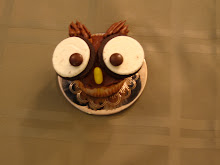
Remember those girl scout cookies you used to eat by the dozen? Well here's a slightly grown up cousin of theirs, adapted from a recipe in Martha Stewart's Cookie book. The hint of peppermint hiding beneath the rich chocolate flavor is superbly refreshing and the crushed candy topping gives the entire cookie an old school charm.
Chocolate Peppermint Cookies: (yields 3 dozen)
1 cup all purpose flour, plus more for dusting
1/2 cup unsweetened dutch processed cocoa
1/2 tsp baking soda
1/2 tsp baking powder
1/2 tsp. salt
2 tbs. butter softened
3/4 cup sugar
1 large egg
1 egg yolk
3/4 tsp pure peppermint extract
2 lb coarsely chopped white chocolate
20-30 crushed peppermint candies
Tip: To crush peppermint candies place them in a ziplock bag and hit them with a meat tenderizer or rolling pin (My husband loves to do this for me).
1) Preheat oven to 325 F
2) Sift together flour, cocoa, baking powder, baking soda, and salt.
3) Beat butter and sugar together for one minute in a mixer on medium.
4) Reduce speed to low and egg, then add yolk.
5) Beat in peppermint extract
6) Add cocoa mixture slowly.
7) Wrap dough in plastic and refrigerate until firm. It may be necessary to place it in the freezer for several minutes.
8) Roll dough into jawbreaker size balls and place on parchment lined baking sheets. Make sure to leave room for cookies to expand.
9) Bake cookies until dry, about 12 minutes.
10) Lift parchment paper onto a wire rack and allow cookies to cool.
11) Melt chocolate in a double boiler.
12) Use a fork to dunk cookies into the chocolate, rotate cookie to evenly coat and to let excess drip off.
13) Dust with chocolate and place in fridge for up to three hours to allow chocolate to dry.
These cookies are great for the holidays, but who needs to wait until then? Bake a bunch today and I promise they won't last past the weekend.
 . However when it was all done and the pie was in the oven the smell was great. The trick for great flaky crust is to make sure your butter is cold. Nice cold butter pieces = flaky dough.
. However when it was all done and the pie was in the oven the smell was great. The trick for great flaky crust is to make sure your butter is cold. Nice cold butter pieces = flaky dough.






